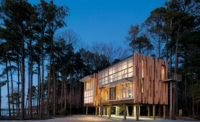In 1998, the British critic Martin Pawley rather dramatically announced what he called “the strange death of architectural criticism.” Pawley lamented the disappearance of an aggressive, “take-no-prisoners” approach to critical writing about architecture, which he felt was being replaced by “wall-to-wall testimonials of praise.”

I wonder what Pawley, who served as architecture critic for both the Guardian and Observer newspapers and died in 2008, would say about the state of the field today, particularly in this country. If the praise, at least for certain celebrity architects, has grown even more over-the-top, the number of critics has also dramatically declined since his piece appeared.
The years since 1998 brought wave after wave of consolidation, buyouts, and layoffs in the newspaper business. At American dailies, there are fewer than a dozen writers covering architecture with any regularity, and perhaps just four or five full-time critics.
As a member of that shrinking fraternity — I joined the Los Angeles Times as architecture critic in late 2004 — I can attest that the field is undergoing a radical transformation keenly felt even by those of us whose official titles haven’t changed. It is not just that our numbers have fallen, but that the way we go about our jobs has been reconfigured by the digital age. There was no Twitter in 1998, no Facebook, and no iPad; newspaper websites were a mere shell of the overstuffed catalogue of links, video, ad banners, and breaking-news alerts they are today.
At the same time, our deadlines are tighter now than ever, thanks to the split-second demands of Internet culture, which can make the cycle of daily journalism appear leisurely. The result is that our critical attention is now scattered across several platforms, as we write pieces for blogs and for the print edition and then promote them via social networking, TV, and radio. And we find ourselves competing with bloggers, historians, videographers, and practicing architects, all of whom have taken advantage of these new conditions to produce a sort of criticism that didn’t exist even five years ago.
The quality of that criticism, as you might guess, is wildly uneven: for every blogger whose prose voice seems to have emerged fully formed, like Geoff Manaugh of BLDGBLOG, there are 10 others whose work — overlong, prone to self-absorption, and still struggling to get a handle on the it’s/its dilemma — appears to exist only to prove the old adage that it’s the editor who makes the writer.
And yet as much as this brave new multi-platform world can seem dizzyingly unpredictable, it has also brought with it new kinds of freedom and critical range. The truth is that American architecture critics — even, and perhaps especially, at beleaguered big-city dailies — are today writing about a richer variety of subjects and, thanks to the Internet, reaching more readers, than has ever been the case. Those readers, for their part, can now choose from a wide range of online criticism, from brief Twitter alerts to annotated photo galleries to long, carefully considered essays. And compared with architecture and design magazines, which — apologies to present company — rarely say a negative word about an architect or a building, most newspaper criticism remains quite pointed.
It helps, of course, to have forward-looking editors, or at least open-minded ones. My higher-ups at the Times have encouraged me to define my job in broad terms, to write about architecture proper but also about planning, green design, preservation, landscape architecture, real-estate power plays, and mass transit. In many ways my beat is not simply architecture but the lives of cities. In a place like Los Angeles, which is still a fairly young and maturing metropolis and faces a series of fundamental questions in the coming years about just what kind of city it desires to be, that often feels like one of the most vital beats at the paper.
But is there such a thing as too much freedom? If any building can be assessed as a work of architecture, as Reyner Banham taught us decades ago, and if every platform is now capable of carrying criticism, from a video tour of a new museum to an old-fashioned 1,500-word essay in the Sunday arts section on the legacy of James Stirling, how does a critic decide?
If the critic does happen to generate a semi-novel, even potentially useful idea about an architect, a building, a stylistic movement, or a zoning change, where should that idea go, exactly? What form should it take? If you’re on Twitter, after all, that means you’re not working on that blog post you promised your editor, to say nothing of that Stirling essay, now two days overdue.
As surprising as it might sound, I don’t know if I would trade our uncertain, fragmented world of criticism for the old one, which provided stability, to be sure, but also allowed critics a certain untouchable, privileged isolation.
As much as the blogosphere often turns crucial issues into soap-operatic fodder, it also keeps us honest to a degree that didn’t exist before. What has emerged is an architecture criticism less contemplative, perhaps, but more nimble — and better attuned to its audience, in ways good and bad. Martin Pawley might not recognize this new criticism right away, but even he, I think, would have to admit its heartbeat is plenty strong.
Los Angeles TimesThe Green House: New Directions in Sustainable Architecture



Post a comment to this article
Report Abusive Comment